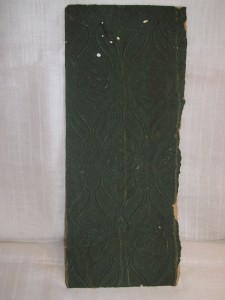The Lincrusta wallcovering is a British invention of Frederick Walton, also the inventor for the Linoleum floor coverings. It was launched in 1877 and was originally fabricated in Sunbary-on-Thames. Today, this wallpaper is produced in Morecambe, in Lancashire, England, using traditional methods and many of the original rollers.
Lincrusta wallpapers met with immediate success and are still used today in the decoration of interior spaces all over the world. Lincrusta is a deeply embossed wallcovering and its reliefs are designed to imitate embossed leather or metal, as well as carved wood and plaster. Part of the reason for its popularity is that it made possible to have the look of very expensive decoration at a reasonable cost. Because of it rigidity and weight, Lincrusta came in sheets and was installed below chair rails and sometimes on ceilings. It was also designed as borders, friezes and dados.
The popularity of Lincrusta spread far and wide. It was used in homes, public and government buildings, railroad cars, even steamships like 6 luxury cabins on the Titanic and famous buildings like the White House and the John D. Rockefeller’s house in New York City. The Victorian era absolutely fell in love with Lincrusta.
It could be painted and decorated with glazes, even gold leaf. The ingredients for Lincrusta were linseed oil, resins and wood flour. As it aged, Lincrusta would harden, which gave it exceptional durability. This is why well-preserved examples of Lincrusta can be found all over the world today, like this sample from the 1920’s taken from a Chicago building on Clark street before it was demolished in the 1990’s.
Lincrusta is one of the many specialty wallcoverings that the craftsmen from Painting in Partnership from the Chicago install and decorate for its clients.








 Follow
Follow
